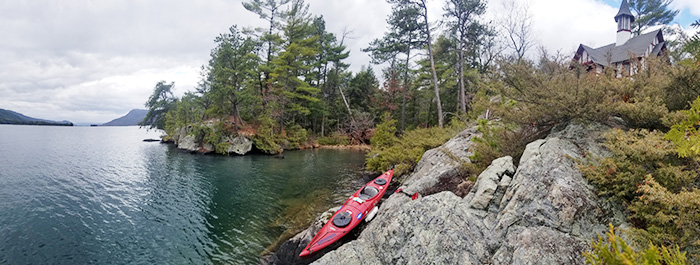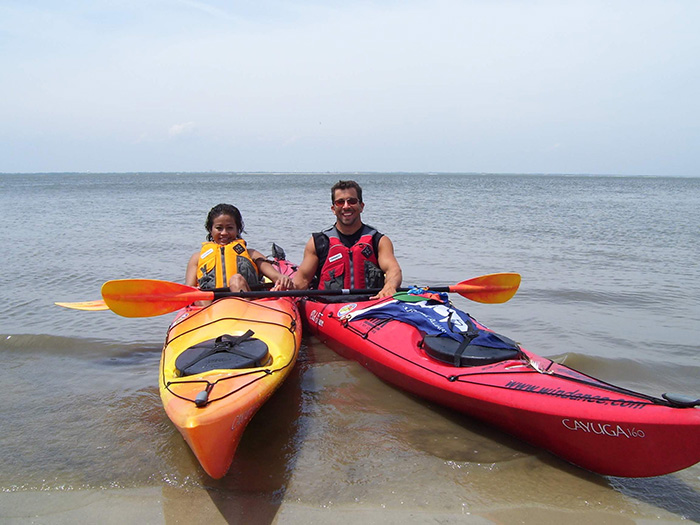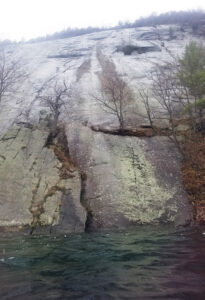By Bob Weinman, Special to The Chronicle
Editor’s note: Bob Weinman of Queensbury in 2021 set out to paddle Lake George each month of the year. He’s writing about it this year in The Chronicle.
April 17, 2021, 8:40 am. Ticonderoga Creek at the north end of Lake George. I stand barefoot in goose poop and consider how lucky I am.
It’s a damp, cold, gray day, and I am “immersed” in nature. I rinse goose grit from between my toes and slip into my kayak. A current nudges me under the Alexandria Avenue Bridge toward the dam. I find myself without my paddle and panic. Ah, there it is, on shore. I claw at the water like a feral cat. I reach shore, grab my paddle, and point south, starting the 32-mile journey towards Lake George Village.
April 17, 1776, this same week, 245 years ago, Ben Franklin, age 70, prepared to cross Lake George. He expected to die.

In Russell Bellico’s book, Chronicles of Lake George-Journeys of War and Peace, Ben seemed uneasy about his trip, but, despite rascally winds and ice pack, he made it. Actually he persisted for another 14 years. Just long enough to complete a little nation building project called the American Revolution.
Isn’t it crazy to think that just 10 generations ago Lake George was a war zone for world superpowers? It was like the Greater Middle East is today. Large corporations scrambled for mangy furs like they do now for fossil fuel. Supernations scrapped about boundaries, while spending their lunch money on the latest war gadgets. And the indigenous population found itself swirled up in the whole mix, forced to pick sides, while reconciling with strange, new alien ideologies and germs.
Franklin once wrote “There was never a good war, or a bad peace.”
Today, we snow ski, water ski, jet ski, and surf ski the same terrain. Occasionally one of us will stumble upon a musket ball, a clay pipe, or a flint projectile point and realize the scars of human conflict are just under the surface of the water, moss, and trees.
The persistent resilience of nature recovers all things. To a point?
Ticonderoga is a crafty creek, pulling Lake George slowly from her cozy basin. In a series of five different waterfalls over four miles, the creek, also known as La Chute River, becomes quiet and lazily deposits the remnants of Lake George into the Lake Champlain basin.
The lake’s demise seems much like how most things pass away, including us. Age, illness or chance sneaks up like a barely notable undertow. Belatedly we recognize and respond, but inevitably we relent and dissolve into something bigger than us.
As Ben himself said, “In this world nothing can be said to be certain, except death and taxes.”
April 17, 1790, Ben paid his last taxes at age 84. “Wish not so much to live long as to live well” he said. Not wanting to choose, he did both and his influence has inspired well beyond what he could do singularly as one man.
I get a little irritated by the mortal nature of life. Do you? I notice however, that beyond the initial despair of loss, there yields a sublime beauty that is equal to or greater than the loss. Consider that Lake George becomes Lake Champlain which becomes the St. Lawrence which finally becomes the vast Atlantic. Moisture from the Atlantic then evaporates, rising gracefully into the clouds to start the cycle all over again with life-giving, and sometimes inconvenient, rain and snow.
It appears to me that life is a cycle of sharing and inspiring. All that we are and have, is borrowed, not owned. Collectively, we are part of something much larger than any one of us.
I sense movement in the sky and look up to see a bald eagle landing in a leafless tree. Tiny droplets land on my glasses. It has started to rain. I paddle past a rock island with a plaque commemorating Diane Struble’s becoming the first person to swim the length of Lake George in 1958. Diane was a small, strong, spunky woman whose story inspired me to first consider paddling the lake.
Another spunky woman who inspired me, was my wife Evelyn.

April 17, 1961, 60 years before my paddle today, Evelyn, was born in Guam. Unlike Franklin, she did not get the extended contract on life. Cancer took her early at age 57. She was four-foot-ten, with a ten-foot-four attitude. She was a firecracker and her gift to live “well,” as Ben put it, to love, laugh, live and give…loudly. In all challenges her sparky, sunny, single-minded soul was resolute.
When told her cancer was terminal, I asked her, “What should we do?”
“Let’s get Thai food.” was her answer.
She wasn’t graceful, but she had grace of another kind. When Evelyn passed, she escaped a burdensome body. Her witty, wild, and willful soul was fully released to inspire all who knew her.
Evelyn hated paddling, which is ironic for a girl who grew up an island, but since her passing, her spirit is with me on every paddle, and we talk a lot. Most of the time, we get along.
Kayaking is one of those harmonic outdoor activities that is good for the soul. Like walking, running, biking or gardening there is a cadence and connection between our bodies and the outdoors that just seems to quiet all that noise our brains create.
In the silence, we find room for reflection, recovery, and redirection. I decided to paddle today because it was Evelyn’s birthday.
In the mist Evelyn and I paddle past Heart Bay named for its iconic shape. The southern shore of the heart is missing, leaving it exposed to the south winds of open water. Evelyn was my southern shore, now missing but in memory, but I understand that the exposure allows me to better appreciate what a safe harbor we once had. In a way, the rough waters make me more resilient and more compassionate for others who have experienced similar loss.
We pass the old windmill, on Windmill Point. The actual sails are long-gone, along with the remains of what was once the Rogers Rock Inn, but just beyond the point remains the more permanent 700-foot Rogers Slide, named for the famous scout Robert Rogers, from the French and Indian wars of the 1700’s.
The rock is important to me from my memory of climbing the face together with Evelyn on a route called Little Finger. I remember her excitement on reaching the top of the climb. She brought pickled mango to celebrate.
John Muir once wrote, “Everybody needs beauty… places to play in and pray in where nature may heal and cheer and give strength to the body and soul alike.”
Lake George is one of those places. As I look around me, I see the collective work of so many individuals who understood and understand how important it is to preserve this basin of healing waters and scenery. So many of these individuals have passed, but their legacy continues to heal people like me in the present.
Rogers Rock itself was donated by the Adams and Lavin families to the Lake George Land Conservancy several decades ago and the LGLC transferred the property to New York State in 2003.

Evelyn and I paddle further south, passing Anthony’s Nose, the Last Great Shoreline, Gull Bay Preserve and finally pause to look up in wonder at Uncas Cliff. All preserves of LGLC.
It is midday when I pull my kayak up on Hecker Island to visit the Chapel of Isaac Jogues. I discover a small cluster of three spring flowers pushing through the still cold soil. To me they represent the promise of recovery in nature. I leave several pebbles there, as prayer beads for Evelyn and several others I love.
Then I slip back into the water. The day remains gray. Evelyn and I sing together for the length of lake, arriving at Tea Island just before dusk.
I circle back to Diamond Island where nearly 20 years ago I proposed to Evelyn with a ring made from a crystal I had found as a boy snorkeling off the same point. I say a quick prayer while watching the sunset together. I feel healing and promise for the future.
Bob Weinman – Bob noun. A guy who floats
Copyright © 2022 Lone Oak Publishing Co., Inc. All Rights Reserved
 Glens Falls Chronicle Serving the Glens Falls/Lake George region; Warren, Washington and northern Saratoga counties since 1980
Glens Falls Chronicle Serving the Glens Falls/Lake George region; Warren, Washington and northern Saratoga counties since 1980

